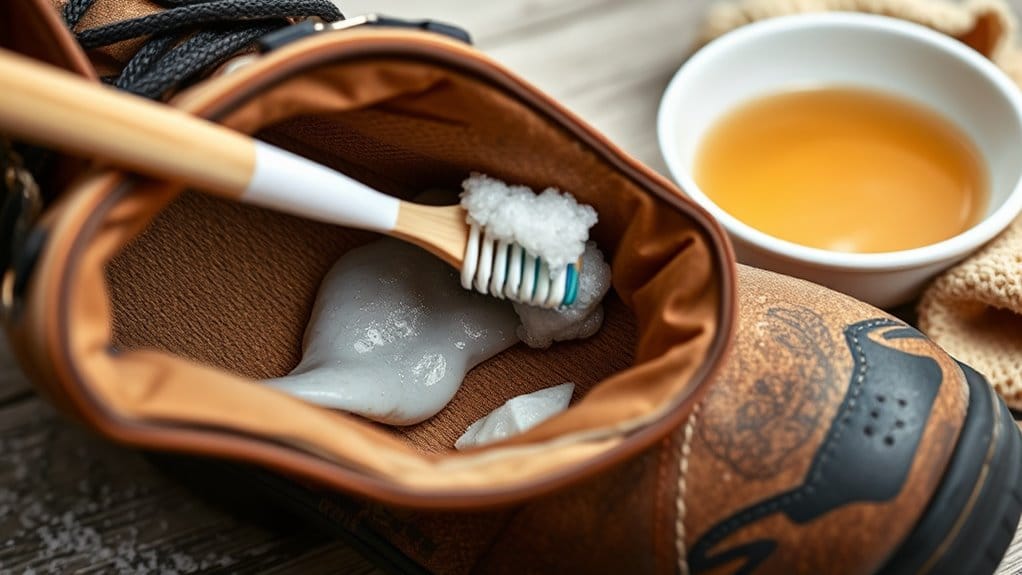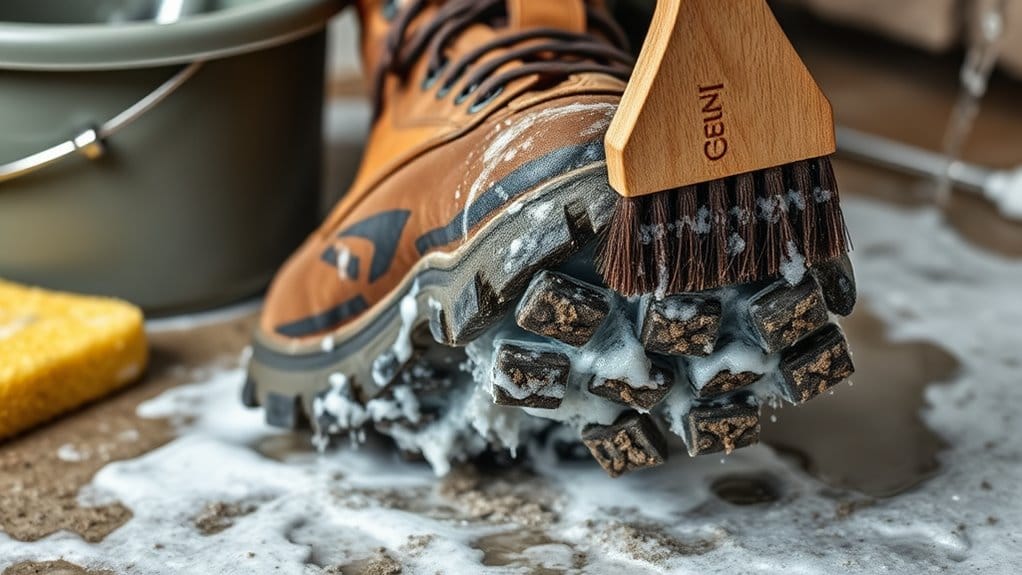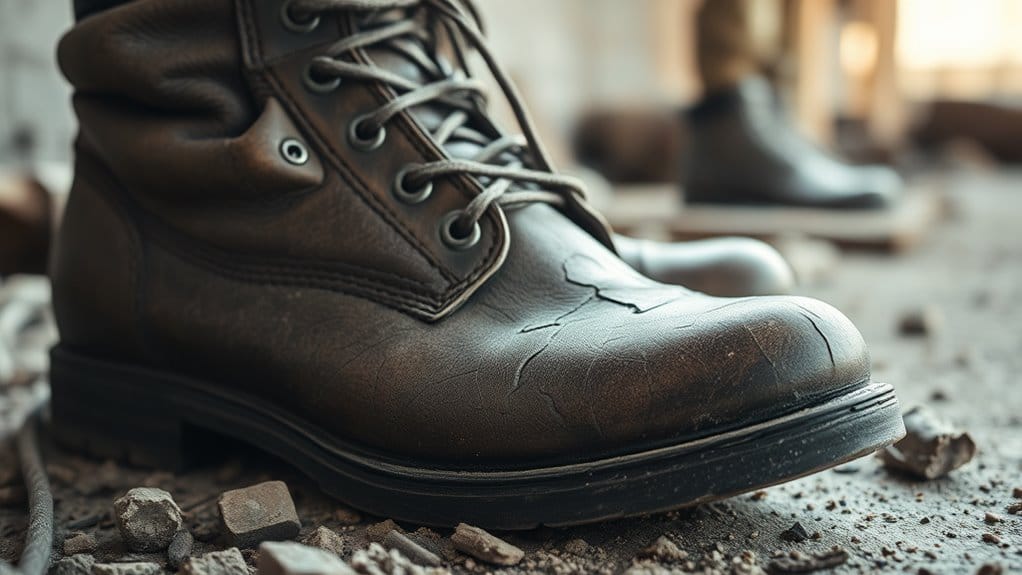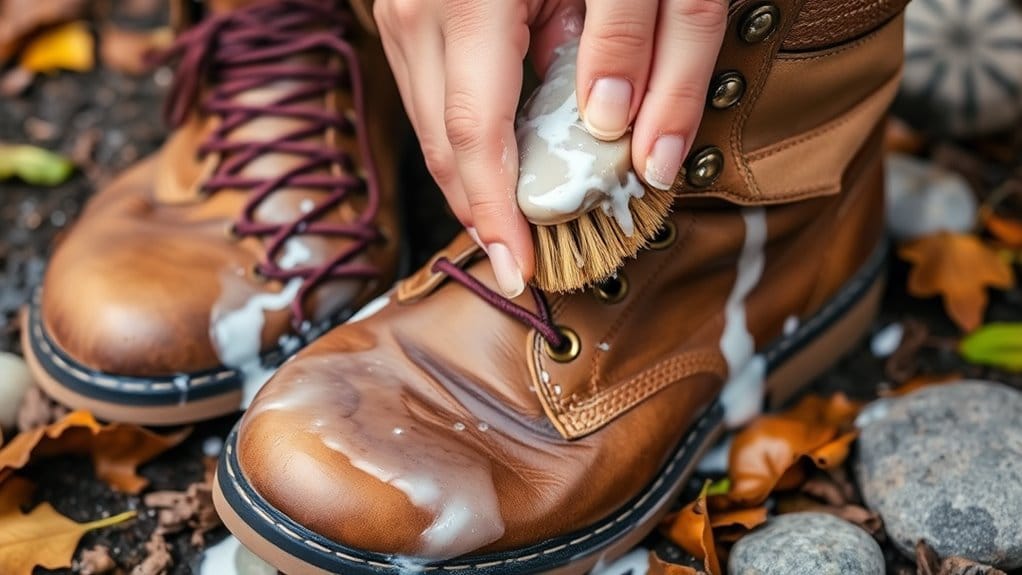This post contains affiliate links. As an Amazon Associate, we earn from qualifying purchases.
To clean your work boots, start by removing dirt with a boot brush. Mix mild soap with warm water, scrub the leather gently, and wipe away grime with a damp cloth. Don’t forget to clean the insoles and soles thoroughly too. After your boots are clean, apply a leather conditioner to keep them supple and prevent cracking. Regular care helps maintain comfort and longevity. If you want more tips on maintaining your boots, keep going!
Key Takeaways
- Use a boot brush to remove dirt and debris before cleaning your work boots.
- Mix warm water with mild soap, such as saddle soap, for effective cleaning.
- Gently scrub the leather and wipe away grime with a damp cloth in circular motions.
- Clean insoles separately using a gentle cycle in the washing machine or hand wash.
- Apply leather conditioner after cleaning to replenish oils and maintain flexibility.
Importance of Regular Boot Care
When you neglect to care for your work boots, you risk not only their longevity but also your comfort and productivity.
Regular boot care is essential; it extends their lifespan by protecting against dirt, grime, and environmental factors that can cause leather to crack. By consistently cleaning and applying leather conditioner, you replenish vital oils in the leather, maintaining flexibility and preventing brittleness.
If you work in harsh conditions, clean and condition your boots monthly; otherwise, every 3 to 6 months should suffice. This maintenance not only enhances the appearance of your boots but also guarantees they perform at their best, directly impacting your comfort on the job.
Essential Cleaning Supplies
To keep your work boots in top shape, you’ll need some essential cleaning supplies.
Start with the right tools like brushes and rags, and don’t forget a mild soap for effective cleaning.
Finally, conditioning products are key to maintaining the leather’s flexibility and preventing cracks.
Must-Have Cleaning Tools
Cleaning your work boots requires a few essential tools to guarantee they stay in top shape.
Start with a boot brush to effectively remove dirt and debris from the surface and seams. For leather boots, mix mild soap, like saddle soap, with warm water for a gentle cleaning solution. You’ll need a soft, clean rag to wipe away grime and excess soap after scrubbing.
Don’t forget a toothbrush or horse-hair brush; these are perfect for reaching creases and the welt without damaging the leather.
Finally, a quality leather conditioner is vital for replenishing essential oils, maintaining flexibility, and extending the durability of your boots after cleaning.
With these tools, your work boots will look great and last longer.
Recommended Cleaning Solutions
After gathering your must-have cleaning tools, it’s time to choose the right cleaning solutions for your work boots.
Start with warm, soapy water mixed with a mild soap, like saddle soap, to effectively lift dirt and grime from the leather. Use your boot brush to scrub the surface and a smaller brush, such as an old toothbrush, for those hard-to-reach seams and crevices.
For deeper cleaning, consider a specialized leather cleaner designed to preserve the leather’s integrity while removing stubborn dirt.
Always remember to conduct a patch test with any new product on a less visible area to avoid damage or discoloration. This way, you guarantee your boots stay clean and maintain their appearance.
Conditioning Products for Leather
Conditioning products play an essential role in maintaining the longevity and appearance of your leather work boots. When selecting conditioning products for leather, opt for high-quality options that replenish essential oils while avoiding petroleum-based ingredients, which can degrade the leather over time.
Regular conditioning is vital; apply conditioner every month for boots exposed to harsh conditions or every 3 to 6 months for those worn less frequently. Look for conditioners specifically formulated for leather, as they effectively penetrate and nourish the material, preventing cracking.
Always conduct a patch test on a less visible area before applying new products to verify compatibility. After conditioning, let the leather dry naturally at room temperature, avoiding direct sunlight or artificial heat sources.
Step-by-Step Cleaning Process
To keep your work boots in top shape, start by removing dirt and debris with a boot brush, along with a smaller brush for those hard-to-reach seams.
Next, prepare a cleaning solution using warm water mixed with a mild soap, like saddle soap, to effectively clean leather without risking damage.
Dip a brush into the soapy water and gently scrub the leather, creating a light lather. Wipe away any remaining grime with a damp cloth, using circular motions and rinsing the cloth often to avoid reintroducing dirt.
Finally, after your boots dry naturally at room temperature, apply a quality leather conditioner to replenish essential oils, ensuring flexibility and preventing cracking. Your boots will thank you!
Deep Cleaning the Interior and Insoles

To deep clean the interior of your work boots, start by removing the insoles.
Once they’re out, you can focus on scrubbing the inside surfaces to tackle dirt and odors effectively.
This step not only refreshes your boots but also enhances your foot hygiene.
Remove Insoles Thoroughly
Start by removing the insoles from your work boots, as this step is vital for a thorough clean. The insoles often harbor moisture and odor, so it’s important to give them special attention.
You can clean the insoles by either washing them in a washing machine on a gentle cycle with mild soap or hand washing them with a low-pH shampoo to avoid damage.
After you remove the insoles, make certain to let them dry completely to prevent any lingering smells. To maintain the shape of your boots while they dry, consider using a shoe tree or suspending them upside down.
Taking these steps guarantees your work boots stay fresh and comfortable for your next wear.
Clean Interior Surfaces
Cleaning the interior surfaces of your work boots is essential for maintaining their freshness and hygiene.
Start by removing the insoles and washing them separately. You can either toss them in the washing machine with mild soap or clean them by hand using low-pH shampoo.
For the interior of the boots, use a damp cloth with low-pH shampoo, scrubbing any dirty areas. If it’s heavily soiled, make sure you rinse thoroughly:
- Blot excess moisture with a clean, dry cloth.
- Air-dry your boots naturally at room temperature, preferably overnight.
- Use a shoe tree or suspend them upside down to maintain shape.
- Avoid moisture buildup to keep them fresh.
With these steps, you’ll effectively clean your boots and extend their lifespan.
Effective Techniques for Leather Boots
While leather work boots are built to withstand tough conditions, they still require proper care to maintain their durability and appearance.
Start by removing dirt and debris using a boot brush, along with a smaller brush for seams. Next, create a cleaning solution with warm water and mild soap, like saddle soap.
Gently scrub the leather with a damp brush to avoid damage. After scrubbing, wipe away grime using a damp cloth in a circular motion, rinsing it frequently to eliminate any soap residue.
Finally, condition the leather with a high-quality conditioner to replenish essential oils, keeping it flexible and preventing cracks.
Regular cleaning and conditioning will greatly extend the lifespan and performance of your leather work boots.
Cleaning the Soles: Best Practices

Maintaining the soles of your work boots is just as important as caring for the leather. To guarantee your boots perform well, follow these best practices for cleaning the soles:
- Use a hard brush to dislodge solid dirt from the tread.
- Extract stones or foreign objects from the grooves with tweezers.
- Wash the soles with a brush and mild soap detergent, scrubbing all areas to eliminate buildup.
- Rinse with water to remove soap residue and wipe down with a damp cloth.
Don’t forget to clean the inside of your boots, as this helps prevent odors and keeps them fresh.
Allow the soles to dry completely before wearing them again to avoid moisture-related issues.
Conditioning Leather for Longevity
Regularly conditioning your leather work boots is essential for their longevity and performance. Conditioning leather replenishes essential oils that prevent drying and cracking, which can greatly shorten their lifespan.
If you’re working in harsh conditions, aim to condition your boots every month; otherwise, every 3 to 6 months should suffice for less frequent use. When applying the conditioner, use a clean rag or your hands to spread it evenly, but don’t over-saturate to avoid sticky residue.
Allow your conditioned boots to dry overnight at room temperature to help the leather absorb the oils effectively. Using high-quality leather conditioners designed specifically for your boots enhances water resistance and overall durability, ensuring they last longer on the job.
Common Causes of Leather Cracking

Leather cracking is often a result of the material drying out, losing its moisture and flexibility.
Accumulated dirt and oil can worsen this issue, making your boots more prone to damage.
To keep your work boots in top shape, it’s essential to understand these causes and how to prevent them.
Drying Out Leather
When your work boots dry out, they become vulnerable to cracking, which can compromise their durability and comfort.
Leather cracking occurs mainly due to a lack of moisture, resulting in decreased flexibility and strength. To prevent this, consider the following factors:
- Exposure to direct sunlight
- Extreme temperatures
- Infrequent cleaning
- Lack of conditioning
Regularly conditioning your leather boots, ideally every 3 to 6 months, helps replenish essential oils and moisture.
If you’re in harsh conditions, do it monthly. This proactive care considerably reduces the risk of drying out and cracking.
Dirt and Oil Accumulation
Although you mightn’t notice it at first, dirt and oil can silently accumulate in the pores of your work boots, leading to a lack of moisture and ultimately causing cracks.
Elements like mud, grease, and chemicals from your workplace exacerbate this issue, increasing leather dryness and deterioration. If leather boots remain consistently exposed to moisture without proper drying, they can dry out and crack.
Moreover, accumulated grime can irritate the leather’s dye and texture, causing discoloration and weakening the material.
To prevent this, regularly clean your leather boots with suitable products. This not only removes dirt and oil but also helps maintain moisture, greatly extending the lifespan of your work boots.
Regular maintenance is key!
Protective Measures for Your Boots
To keep your work boots in top shape, it’s essential to adopt a few protective measures.
These steps will help maintain the quality of the leather and extend the life of your boots:
- Regularly clean and condition your boots to prevent leather cracking from dirt and dryness.
- Store them in a cool, dry place, away from direct sunlight to avoid material degradation.
- Apply waterproofing agents if you expect moisture exposure, ensuring your boots remain protected against the elements.
- Use boot trees or stuff them with newspaper during storage to help retain their shape and prevent creasing.
Tips for Maintaining Foot Health

Maintaining foot health is essential for anyone who spends long hours in work boots. Start by regularly changing your socks, choosing moisture-wicking materials to keep your feet dry and hygienic. This simple step helps prevent bacteria and fungi from thriving in your boots.
Consider using antifungal powder on the insoles and inside your boots; it controls moisture and odor, reducing the risk of athlete’s foot. Allow your boots to air out during breaks or invest in boot dryers to keep them dry.
Monitor your feet for any signs of irritation or allergic reactions to boot materials. Finally, incorporate a regular foot care routine, treating any conditions promptly to enhance your overall comfort and foot health while wearing work boots.
Conclusion
By regularly cleaning and maintaining your work boots, you not only extend their lifespan but also keep your feet healthy and comfortable. Make it a habit to use the right supplies and techniques for both the exterior and interior of your boots. Don’t forget to condition the leather to prevent cracking and wear. With these simple steps, your boots will stay in top shape, ready to support you in any tough job.



